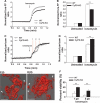Activation of the mitochondrial permeability transition pore modulates Ca2+ responses to physiological stimuli in adult neurons
- PMID: 21255127
- PMCID: PMC3183752
- DOI: 10.1111/j.1460-9568.2010.07576.x
Activation of the mitochondrial permeability transition pore modulates Ca2+ responses to physiological stimuli in adult neurons
Abstract
The participation of mitochondria in cellular and neuronal Ca(2+) homeostatic networks is now well accepted. Yet, critical tests of specific mitochondrial pathways in neuronal Ca(2+) responses have been hampered because the identity of mitochondrial proteins that must be integrated within this dynamic system remain uncertain. One putative pathway for Ca(2+) efflux from mitochondria exists through the formation of the permeability transition pore (PTP) that is often associated with cellular and neuronal death. Here, we have evaluated neuronal Ca(2+) dynamics and the PTP in single adult neurons in wild-type mice and those missing cyclophilin D (CyPD), a key regulator of the PTP. Using high-resolution time-lapse imaging, we demonstrate that PTP opening only follows simultaneous activation with two physiological stimuli that generate critical threshold levels of cytosolic and mitochondrial Ca(2+) . Our results are the first to demonstrate CyPD-dependent PTP opening in normal neuronal Ca(2+) homeostatic mechanisms not leading to activation of cell death pathways. As neurons in mice lacking CyPD are protected in a number of neurodegenerative disease models, the results suggest that improved viability of CyPD-knockout animals in these pathological states may be due to the transient, rather than persistent, activation of the PTP in mutant mitochondria, thereby shielding neurons from cytoplasmic Ca(2+) overload.
© 2011 The Authors. European Journal of Neuroscience © 2011 Federation of European Neuroscience Societies and Blackwell Publishing Ltd.
Figures





References
-
- Abramov AY, Duchen MR. Mechanisms underlying the loss of mitochondrial membrane potential in glutamate excitotoxicity. Biochim. Biophys. Acta. 2008;1777:953–964. - PubMed
-
- Baines CP, Kaiser RA, Purcell NH, Blair NS, Osinska H, Hambleton MA, Brunskill EW, Sayen MR, Gottlieb RA, Dorn GW, Robbins J, Molkentin JD. Loss of cyclophilin D reveals a critical role for mitochondrial permeability transition in cell death. Nature. 2005;434:658–662. - PubMed
-
- Basso E, Fante L, Fowlkes J, Petronilli V, Forte MA, Bernardi P. Properties of the permeability transition pore in mitochondria devoid of cyclophilin D. J. Biol. Chem. 2005;280:18558–18561. - PubMed
-
- Bernardi P. Mitochondrial transport of cations: channels, exchangers, and permeability transition. Physiol. Rev. 1999;79:1127–1155. - PubMed
-
- Bernardi P, Petronilli V. The permeability transition pore as a mitochondrial calcium release channel: a critical appraisal. J. Bioenerg. Biomembr. 1996;28:131–138. - PubMed
Publication types
MeSH terms
Substances
Grants and funding
LinkOut - more resources
Full Text Sources
Molecular Biology Databases
Research Materials
Miscellaneous

